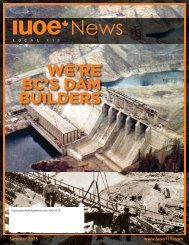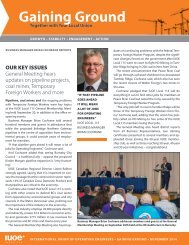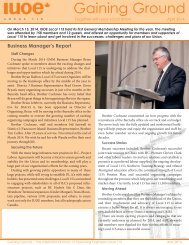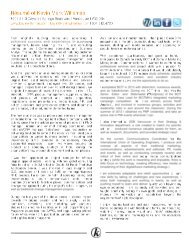A brief history of Unions in Canada
A look at the influence, history, and importance of Unions in Canada. Shared with permission of Dr. Brendan Sweeney and SAY Magazine.
A look at the influence, history, and importance of Unions in Canada. Shared with permission of Dr. Brendan Sweeney and SAY Magazine.
Create successful ePaper yourself
Turn your PDF publications into a flip-book with our unique Google optimized e-Paper software.
UNIONS<br />
20 • SAY - LABOUR Special 2013<br />
By Dr. Brendan Sweeney, McMaster University<br />
<strong>Unions</strong> have played an important role <strong>in</strong> <strong>Canada</strong> for over 100 years. While they orig<strong>in</strong>ally<br />
consisted primarily <strong>of</strong> skilled craftsmen important to life <strong>in</strong> the 19th century – like blacksmiths,<br />
barrel-makers, pr<strong>in</strong>ters, and brewers – today’s unions represent a diverse group<br />
<strong>of</strong> workers. Teachers, nurses, m<strong>in</strong>ers, autoworkers, police <strong>of</strong>ficers, fire fighters, university<br />
and college pr<strong>of</strong>essors, and NHL players are members <strong>of</strong> today’s unions. In fact, almost<br />
one-third <strong>of</strong> all workers <strong>in</strong> <strong>Canada</strong> are members <strong>of</strong> unions.<br />
So what exactly do unions do? Once a majority <strong>of</strong> workers <strong>in</strong> a given workplace or <strong>in</strong>dustry<br />
decide that they want to be represented by a particular union (<strong>of</strong>ten through a secret<br />
ballot vote), that union takes on several functions.<br />
The first is to negotiate an agreement with the employer that outl<strong>in</strong>es the terms and conditions<br />
<strong>of</strong> employment, <strong>in</strong>clud<strong>in</strong>g wages, benefits, hours <strong>of</strong> work, and health and safety<br />
regulations. This happens through a process <strong>of</strong> collective barga<strong>in</strong><strong>in</strong>g, and the result is a<br />
legal contract called a collective agreement. These agreements generally last from three<br />
to five years, although longer and shorter contracts are not uncommon.<br />
In <strong>in</strong>stances where the employer and the union do not agree on specific issues, mediators,<br />
conciliators, and arbitrators may be brought <strong>in</strong> to help. In some cases, the two parties<br />
may reach an impasse, which may be followed by a work stoppage.<br />
There are two ma<strong>in</strong> types <strong>of</strong> work stoppages: a strike (where workers refuse to go to<br />
work) and a lockout (where the employer refuses to allow employees to work). Strikes<br />
and lockouts were much more common <strong>in</strong> the 1970s and 1980s, however, the vast<br />
majority <strong>of</strong> collective agreements <strong>in</strong> <strong>Canada</strong> are negotiated without a day lost to a work<br />
stoppage.<br />
Another important function <strong>of</strong> unions is to manage conflict and disagreement <strong>in</strong> the<br />
workplace. This <strong>of</strong>ten comes <strong>in</strong> the form <strong>of</strong> grievances, which happen when one party<br />
alleges that the other has contravened a rule <strong>in</strong> the collective agreement. Union representatives<br />
and managers then follow a process that helps them come to a fair resolution and<br />
ensures that the grievance does not disrupt the efficient operation <strong>of</strong> the workplace.<br />
In some very serious cases, grievances may by referred to a mediator or an arbitrator,<br />
who make (or help make) a solution based on the law, the collective agreement, previous<br />
arbitration decisions, and what is best for the workplace.<br />
<strong>Unions</strong> may also play a significant role <strong>in</strong> jo<strong>in</strong>t union management committees. These<br />
committees are designed to br<strong>in</strong>g together workers and managers to solve problems <strong>in</strong><br />
the workplace. Some common issues that these committees might work to address <strong>in</strong>clude<br />
health and safety, gender and equity issues, and improv<strong>in</strong>g workplace productivity.<br />
F<strong>in</strong>ally, unions play an important role <strong>in</strong> our political system. Many unions have historically<br />
allied with the New Democratic Party, however, several have begun to support a variety<br />
<strong>of</strong> political parties at both the prov<strong>in</strong>cial and federal level. These unions may lobby government<br />
for changes to the law and policies <strong>in</strong> order to help support specific <strong>in</strong>dustries, to<br />
ensure that there is adequate fund<strong>in</strong>g for the sectors <strong>in</strong> which their members work, and to<br />
help work<strong>in</strong>g Canadians improve their health, well-be<strong>in</strong>g, and standard <strong>of</strong> liv<strong>in</strong>g.<br />
<strong>Canada</strong>’s first unions emerged around the time <strong>of</strong> Confederation. The majority <strong>of</strong> their<br />
members were highly skilled craftsmen. These unions sought to protect their members<br />
aga<strong>in</strong>st competition from employers that cut costs by treat<strong>in</strong>g employees poorly through<br />
the use <strong>of</strong> child labour and from be<strong>in</strong>g made redundant by new technologies. They also<br />
provided members with basic assurances <strong>of</strong> health care and funeral benefits (an early<br />
form <strong>of</strong> life <strong>in</strong>surance), and provided opportunities for socialization, fraternization, and<br />
recreation. However, these unions were very exclusive and seldom open to women or<br />
anyone who was not <strong>of</strong> British and later Irish, French, or German descent.<br />
In response to the exclusionary practices <strong>of</strong> these unions and the emerg<strong>in</strong>g system <strong>of</strong><br />
<strong>in</strong>dustrial production <strong>in</strong> late 19th and early 20th century <strong>Canada</strong>, new and more <strong>in</strong>clusive<br />
workers’ organizations were created. Two <strong>of</strong> the most famous <strong>of</strong> these were the Knights <strong>of</strong><br />
Labor and the Industrial Workers <strong>of</strong> the World.<br />
These unions had male and female members from diverse ethnic backgrounds. They also<br />
fought for basic rights and freedoms for workers through political channels and promoted<br />
the dignity <strong>of</strong> all types <strong>of</strong> work. Although they were relatively short-lived, they helped<br />
establish some <strong>of</strong> the first labour laws <strong>in</strong> <strong>Canada</strong>, provided a legitimate voice for the<br />
work<strong>in</strong>g classes, and paved the way for a more <strong>in</strong>clusive labour movement.<br />
The modern unions that exist today were established towards the end <strong>of</strong> World War II. Follow<strong>in</strong>g<br />
the lead <strong>of</strong> the United States, which legitimized unions <strong>in</strong> 1935, <strong>Canada</strong> enacted a
law <strong>in</strong> 1944 that allowed workers to freely jo<strong>in</strong><br />
unions and compelled employers to barga<strong>in</strong><br />
with that union.<br />
Moreover, unions and employers were<br />
required to barga<strong>in</strong> ‘<strong>in</strong> good faith’, or <strong>in</strong> other<br />
words, with the honest <strong>in</strong>tent to achieve a<br />
fair and reasonable agreement with<strong>in</strong> the<br />
conf<strong>in</strong>es <strong>of</strong> the law that would m<strong>in</strong>imize<br />
strikes, lockouts, and other work stoppages,<br />
and help establish productive and healthy<br />
workplaces. This is <strong>of</strong>ten referred to as the<br />
‘post-war compromise’ between employers<br />
and workers. Dur<strong>in</strong>g the late 1940s and 1950s,<br />
workers <strong>in</strong> <strong>Canada</strong>’s steel, automotive, m<strong>in</strong><strong>in</strong>g,<br />
forest products, freight transportation, and<br />
construction <strong>in</strong>dustries jo<strong>in</strong>ed unions <strong>in</strong> record<br />
numbers.<br />
Two decades later, the federal and prov<strong>in</strong>cial<br />
governments adopted legislation that gave<br />
public sector workers the right to jo<strong>in</strong> unions.<br />
Throughout the late 1960s and 1970s federal,<br />
prov<strong>in</strong>cial, and municipal government employees,<br />
public school teachers, nurses and other<br />
health care workers, university and college<br />
pr<strong>of</strong>essors, police <strong>of</strong>ficers, fire fighters, and<br />
social services workers began to form unions.<br />
The proportion <strong>of</strong> workers unionized <strong>in</strong> <strong>Canada</strong><br />
grew rapidly dur<strong>in</strong>g this time, and reached a<br />
peak <strong>in</strong> the early 1980s.<br />
Today, three ma<strong>in</strong> types <strong>of</strong> unions exist <strong>in</strong><br />
<strong>Canada</strong>. The first group represents workers<br />
employed <strong>in</strong> the private sector (bus<strong>in</strong>esses<br />
that provide goods and services for a pr<strong>of</strong>it).<br />
Some <strong>of</strong> the biggest private sector unions<br />
<strong>in</strong> <strong>Canada</strong> <strong>in</strong>clude the United Steelworkers<br />
(USW), the United Food and Commercial Workers<br />
(UFCW), and UNIFOR, a new union formed<br />
by a merger <strong>of</strong> the Canadian Auto Workers<br />
(CAW) and the Communications, Energy, and<br />
Paperworkers (CEP). These unions negotiate<br />
collective agreements <strong>in</strong> <strong>in</strong>dividual workplaces,<br />
although <strong>in</strong> many cases they work hard to<br />
ensure that wages and work<strong>in</strong>g conditions are<br />
similar across specific <strong>in</strong>dustries. The members<br />
<strong>of</strong> these unions carry out a wide variety <strong>of</strong><br />
jobs and have an even wider variety <strong>of</strong> skills.<br />
The second group <strong>of</strong> unions represents workers<br />
employed <strong>in</strong> the public sector (government<br />
workers or workers employed by organizations<br />
that rely on government fund<strong>in</strong>g). Unlike the<br />
private sector, work <strong>in</strong> the public sector is<br />
geared towards provid<strong>in</strong>g important services<br />
for the public good, like schools, hospitals,<br />
and power plants. The Canadian Union <strong>of</strong> Public<br />
Employees (CUPE) and the Public Service Alliance<br />
<strong>of</strong> <strong>Canada</strong> (PSAC) are two <strong>of</strong> the largest<br />
public sector unions <strong>in</strong> <strong>Canada</strong>.<br />
These unions <strong>of</strong>ten represent specific pr<strong>of</strong>essions,<br />
like teachers, nurses, police <strong>of</strong>ficers,<br />
and fire fighters, or they may represent groups<br />
<strong>of</strong> workers employed by a specific branch <strong>of</strong><br />
the government (like Revenue <strong>Canada</strong> or prov<strong>in</strong>cial<br />
M<strong>in</strong>istries <strong>of</strong> Transportation). Because<br />
fund<strong>in</strong>g for their employers comes primarily<br />
from taxes, and the services they provide are<br />
so important to the public, their relationships<br />
with their employers <strong>of</strong>ten make the news.<br />
These unions negotiate contracts directly with<br />
employers (e.g. school boards), but also play<br />
an important role <strong>in</strong> protect<strong>in</strong>g and improv<strong>in</strong>g<br />
public services more broadly.<br />
The third group represents workers <strong>in</strong> a<br />
specific trade or occupation. They are <strong>of</strong>ten<br />
referred to as build<strong>in</strong>g and construction trade<br />
unions, and <strong>in</strong>clude electricians, elevator technicians,<br />
plumbers and pipefitters, and heavy<br />
equipment operators.<br />
The members <strong>of</strong> these unions are <strong>of</strong>ten found<br />
work<strong>in</strong>g on large construction projects, such<br />
as highways, airports, m<strong>in</strong>es, and factories.<br />
They also perform ma<strong>in</strong>tenance and repair<br />
work on large build<strong>in</strong>gs and important <strong>in</strong>frastructure.<br />
However, there are also several trade unions<br />
that represent workers outside <strong>of</strong> the construction<br />
<strong>in</strong>dustry, such as the actors’, musicians’,<br />
and screen writers’ associations.<br />
In addition to negotiat<strong>in</strong>g on behalf <strong>of</strong> their<br />
members, trade unions play an <strong>in</strong>strumental<br />
role <strong>in</strong> tra<strong>in</strong><strong>in</strong>g workers (<strong>of</strong>ten through apprenticeships),<br />
ensur<strong>in</strong>g that their members’ skills<br />
are up-to-date, and <strong>in</strong> work<strong>in</strong>g with employers<br />
to ensure that there are job opportunities for<br />
their members.<br />
Jo<strong>in</strong><strong>in</strong>g or becom<strong>in</strong>g <strong>in</strong>volved with a union<br />
is an important decision for young workers.<br />
<strong>Unions</strong> can be very helpful <strong>in</strong> access<strong>in</strong>g work<br />
and tra<strong>in</strong><strong>in</strong>g, ensur<strong>in</strong>g that workers receive fair<br />
wages and benefits, and provid<strong>in</strong>g a voice for<br />
work<strong>in</strong>g peoples.<br />
Many unions, particularly those work<strong>in</strong>g <strong>in</strong><br />
northern resource and <strong>in</strong>frastructure projects,<br />
have also begun to develop relationships with<br />
local Aborig<strong>in</strong>al groups to help improve employment<br />
and tra<strong>in</strong><strong>in</strong>g prospects and m<strong>in</strong>imize<br />
the impact <strong>of</strong> development. For example, at<br />
one m<strong>in</strong>e <strong>in</strong> Labrador, the union and employer<br />
negotiated clauses that made Inuit and Innu<br />
dialects <strong>of</strong>ficial languages <strong>in</strong> the workplace<br />
and established National Aborig<strong>in</strong>al Day as a<br />
paid holiday.<br />
So don’t be afraid to ask questions or discuss<br />
these issues with co-workers and union<br />
representatives if given the opportunity. There<br />
are millions <strong>of</strong> Canadians who are happy that<br />
they did.<br />
Many unions, particularly<br />
those work<strong>in</strong>g <strong>in</strong> northern<br />
resource and <strong>in</strong>frastructure<br />
projects, have<br />
also begun to develop<br />
relationships with local<br />
Aborig<strong>in</strong>al groups to<br />
help improve employment<br />
and tra<strong>in</strong><strong>in</strong>g prospects<br />
and m<strong>in</strong>imize the impact <strong>of</strong><br />
development.<br />
SAY - LABOUR Special 2013 • 21

















